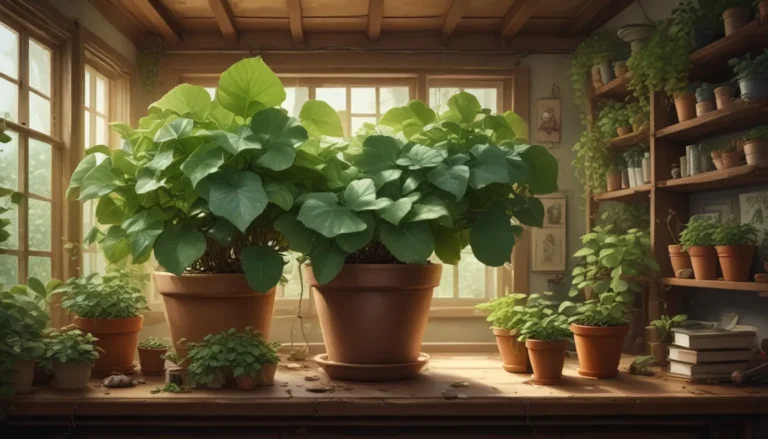The Ultimate Guide to Growing Jacob’s Ladder: A Stunning Shade-Blooming Perennial

Jacob’s ladder, scientifically known as Polemonium spp., is a charming ornamental perennial that thrives in USDA Hardiness Zones 3 to 8, gracing shady spots with its blooms in the late spring and early summer. This perennial is not just a single flower but an entire genus in the Polemoniaceae or phlox family, containing 25 species originating from eastern North America, Europe, and northern Asia.
If you’re looking to add a touch of elegance to your garden with Jacob’s ladder, this comprehensive guide will provide you with all the information you need to cultivate these majestic plants in your landscape.
Understanding Jacob’s Ladder
Jacob’s ladder species are typically found in woodland areas beneath the canopies of trees or along streams where the soil is moist and the air is cool. These plants are known as “ephemerals” because they have a short growing season, die to the ground, and vanish until the next growing season. Jacob’s ladder grows from rhizomes and forms clumps of basal foliage with striking blue, pink, purple, or white flowers that bloom in late spring to early summer.
The leaves of Jacob’s ladder plants are arranged in a ladder rung-like pattern along horizontal stems, with the longest stems located at the bottom. The upright stems of this perennial rise tall to welcome spring and make way for summer, creating a stunning display of color in shady areas of your garden.
How to Grow Jacob’s Ladder
To successfully cultivate Jacob’s ladder in your garden, follow these steps:
-
Planting Locations: Choose completely to partially shaded areas with moist, well-draining, organically-rich soil. Aim for a slightly acidic pH between 6.0 and 7.0.
-
Planting Depth: Direct sow seeds at a depth of approximately one-eighth of an inch, spacing them 12 to 18 inches apart. Ensure even moisture during germination and sprouting, thinning seedlings to the strongest one when they have multiple sets of true leaves.
-
Maintenance: Provide plants with a shady, cool location, barely cover seeds with soil, maintain consistent moisture without allowing the soil to dry out completely, and space plants appropriately to accommodate their mature dimensions and allow for proper airflow.
By following these growing tips, you can ensure that your Jacob’s ladder plants thrive and bloom beautifully in your garden.
Propagation of Jacob’s Ladder
Jacob’s ladder plants can be propagated through seeds, divisions, cuttings, or nursery pots. Here are the different methods of propagation to consider:
From Seed
- Start seeds indoors about eight weeks prior to the last spring frost date.
- Thin seedlings to one per cell after they have developed one set of true leaves.
- Transplant seedlings to the garden after acclimating them to outdoor conditions.
By Division
- Divide mature plants every three years or so in late summer.
- Separate clumps into two or more sections and replant as desired.
From Stem Cuttings
- Take soft stem cuttings in early spring to create additional plants.
- Root cuttings in a container of sterile potting medium.
- Transplant rooted stems to the garden or directly into the soil.
Transplanting
- Transplant potted seedlings or mature plants from nursery pots to the garden by setting them into prepared soil at the same depth they were in their original containers.
- Ensure that the soil remains evenly moist to support healthy growth.
By choosing the right propagation method for your Jacob’s ladder plants, you can easily expand your garden’s collection and enjoy these beautiful perennials in multiple locations.
Pruning and Maintenance Tips
Jacob’s ladder plants are typically low-maintenance in shady locations with moist soil. However, you can perform certain maintenance tasks to keep your plants healthy and attractive:
- Stake drooping stems to support flowers.
- Deadhead spent flowers to maintain plant appearance and potentially encourage a second bloom.
- Remove foliar debris once plants have finished blooming to prevent pest and disease issues.
- Divide plants every three years to create new plants or relocate existing ones as desired.
By following these pruning and maintenance tips, you can ensure that your Jacob’s ladder plants continue to thrive and bloom year after year.
Jacob’s Ladder Cultivars to Consider
When choosing Jacob’s ladder cultivars for your garden, you have a variety of options to explore:
Pearl White
- Description: P. caeruleum ‘Pearl White’ features crisp white blossoms on tall stems up to three feet in height.
- Benefits: This cultivar adds a bright pop of color to shady areas and provides a stunning visual display.
- Availability: Find Pearl White seeds via Amazon in packets of 70+ seeds.
P. reptans
- Description: The native P. reptans boasts pale lavender-blue blossoms on compact stems ranging from 12 to 18 inches in height.
- Benefits: Planting native wildflowers like P. reptans helps preserve these species and support local ecosystems.
- Availability: Purchase P. reptans plants from Nature Hills Nursery in #1 containers or two-by-two-by-three-inch container three-packs.
Stairway to Heaven
- Description: P. reptans ‘Stairway to Heaven’ features lavender-blue blossoms and variegated green and white foliage with hints of pink.
- Benefits: This cultivar combines the beauty of native species with unique foliage coloration for added visual interest.
- Availability: Purchase P. reptans ‘Stairway to Heaven’ from Nature Hills Nursery in #1 containers.
By selecting from these cultivars, you can enhance the visual appeal of your garden and enjoy a diverse range of Jacob’s ladder plants in various colors and foliage patterns.
Managing Pests and Disease
While Jacob’s ladder plants are generally resilient to pests and diseases, they may encounter issues such as aphids, moth caterpillars, slugs, snails, leaf spot, and powdery mildew. To address these problems, consider the following preventive measures:
- Use firm sprays with a hose nozzle or apply organic neem oil to deter pests like aphids and moth caterpillars.
- Set traps or manually remove slugs and snails to prevent damage to the foliage.
- Monitor the plants for signs of leaf spot and powdery mildew, removing affected foliage and applying fungicides as needed.
By staying vigilant and addressing pest and disease issues promptly, you can help your Jacob’s ladder plants stay healthy and vibrant throughout the growing season.
Best Uses for Jacob’s Ladder Plants
Jacob’s ladder is an excellent choice for a variety of garden settings and applications, including:
- Beds and borders
- Containers on patios
- Pollinator gardens
- Shade gardens
- Woodland settings
These majestic plants can be paired with other shade-loving perennials to create a harmonious garden display that transitions seamlessly from spring to summer. Consider companion plants like astilbe, dog-toothed violet, columbine, heuchera, hosta, Japanese painted fern, and torenia to complement your Jacob’s ladder plants and create a visually stunning landscape.
In Conclusion
Jacob’s ladder, with its stunning blooms and elegant foliage, is a versatile and resilient perennial that adds beauty to any garden. Whether you choose native species like P. reptans or non-native cultivars like P. caeruleum, you’re sure to enjoy the regal presence of these plants in your landscape. By following the tips and guidelines provided in this guide, you can successfully grow and maintain Jacob’s ladder plants in your garden, creating a vibrant display of color and foliage year after year.
Have you grown Jacob’s ladder in your garden? Share your experiences and tips in the comments below! If you found this article informative and inspiring, consider exploring other shade-loving perennials to enhance your garden’s beauty and biodiversity.
Remember, with the right care and attention, your Jacob’s ladder plants can become the majestic harbingers of spring and summer in your garden, delighting you and your visitors with their stunning blooms and elegant presence.





